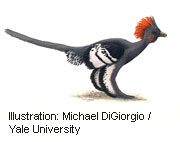
THURSDAY, Feb. 4 (HealthDay News) — For the first time, the colors that adorned a species of feathered dinosaur more than 150 million years ago have been revealed by U.S. scientists who deciphered microscopic clues hidden in a fossil of one of the creatures.
The Yale University team analyzed color-imparting structures called melanosomes in the fossil of the four-winged Anchiornis huxleyi and concluded that the animal had a generally gray body, a reddish-brown Mohawk-like crest, facial speckles and white feathers on its wings and legs, with black-spangled tips.
“This was no crow or sparrow, but a creature with a very notable plumage,” study co-author Richard O. Prum, a professor of ornithology, ecology and evolutionary biology, said in a Yale news release. “This would be a very striking animal if it was alive today.”
The color patterns on the dinosaur’s limbs — much like those of modern-day Spangled Hamburg chickens — likely played a role in communication and helped attract mates, Prum said.
The study, published online Feb. 4 in Science, indicates that color patterning of dinosaur feathers evolved earlier than previously believed. It also offers more evidence that dinosaurs didn’t initially evolve feathers for flight but rather for purposes such as camouflage or mating display.
“Writing the first scientificallybased ‘field guide’ description of the appearance of an extinct dinosaur was an exciting and unforgettable experience — the ultimate dream of every kid who was ever obsessed with dinosaurs,” Prum said. “Now that dream is really possible.”
More information
The American Museum of Natural History has more about dinosaurs and feathers.

